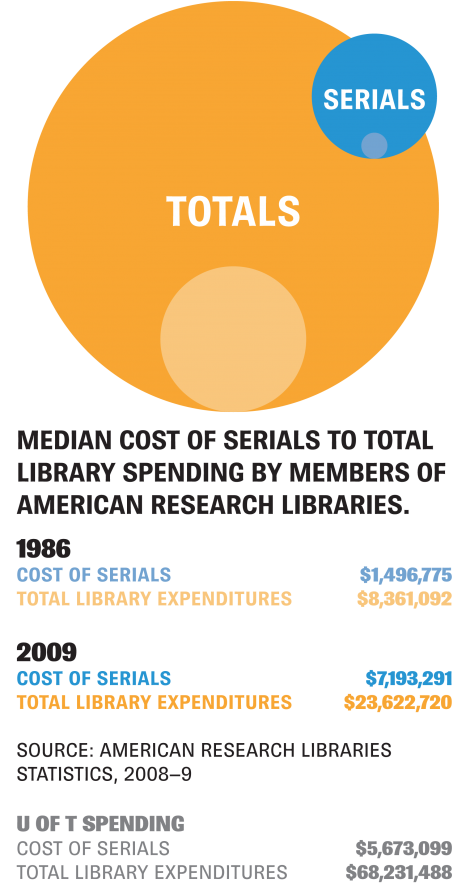Over 12,000 academics, including 55 from the University of Toronto, have signed a petition to boycott Elsevier, a leading academic publisher in the scientific, technical and medical realms. The Dutch corporation has come under fire in recent months for its controversial business model, sky-high prices, and lobbying efforts to restrict academic freedom.
“Elsevier is based on a business model in which academics do almost all the work for free,” explains Dr. Rachel Barney, a philosophy professor at U of T.
Academic publishers like Elsevier do not pay the academics and researchers who submit papers for publication, nor those who peer-review the papers to ensure their accuracy. Much of the research in papers published in journals distributed by Elsevier is funded by taxpayer dollars, enabling the company to keep expenses low.
Elsevier sells these journals back to public institutions like the University of Toronto for tens of thousands of dollars, frequently bundling together different journals to justify raising the sticker price.
Under this arrangement, Elsevier reaped profits of approximately $1.2 billion in 2010, a 36 per cent profit margin that is almost unheard of in the publishing industry.
“We’ve been talking about the astronomical journal price increases for quite a long time,” said Caitlin Tillman, head of collection development for the University of Toronto’s library system. “What’s interesting about this Elsevier boycott is that it comes from the faculty, and not the libraries.”
The boycott began with Cambridge professor Timothy Gowers. In a January 2012 blog post, Gowers vowed that he would not publish, peer review, or serve on the editorial boards of any of the over 2,600 journals Elsevier publishes.
In an official statement released in response to the boycott, Elsevier explains that they do not force libraries to purchase their journals. But librarians say that the journals are so prohibitively priced when purchased individually that they have no choice but to buy in bundles.
“They’ll bundle five or 10 together so that if you want one, you need to buy the whole set,” said Julie Hannaford, Associate Librarian for the Social Sciences and Humanities at U of T.
Journal prices have been rising for over 25 years, says Tillman, adding, “I would say the average price increase was four to five per cent.”
U of T’s libraries receive a yearly two per cent funding increase to cover inflation costs. But the price of journal subscriptions, particularly in science, technology and medicine, have outpaced this allowance, rising by around seven to nine per cent every year explains Tillman.
As a result, journals eat up more of libraries’ budgets, both at U of T and abroad. One survey found that in Britain, school libraries were spending an average of 65 per cent on subscriptions alone.
Last year, the University of Toronto cut all of its print subscriptions to journals that offered digital subscriptions. Tillman warns that “sooner rather then later” the library will have to make cuts that effect content.
Some suggest that part of the problem is the broader structure of academia. In some fields, a publish-or-die mentality has allowed publishers such as Elsevier to entrench their position. Publication credits in certain reputable journals are a key metric for hiring and promoting professors, and it increasingly serves in admissions processes to competitive research programs. Elsevier publishes some of the largest and most well-known journals including The Lancet series of journals.
“This has very little to do with academic publishing,” says James Romanow, co-chair of Access Copyright “All they’ve got to do is stop subscribing and stop using [journal articles] as a metric for hiring and promotion.”
Elsevier is one of the three large commercial publishers in the industry, which together account for approximately 42 per cent of the academic journals printed worldwide. By limiting their boycott to Elsevier, academics can register their objections, while retaining the opportunity to publish their work elsewhere.
“Pretty much across the board Elsevier is the most expensive” says Tillman. She stresses that large academic publishers strictly enforce confidentially agreements, so it is difficult to know for sure.
COPYRIGHT LOBBYING CEMENTS FRUSTRATION
A growing sense of frustration with Elsevier was further cemented when the company last year announced its support for controversial American copyright laws including the Stop Online Piracy Act, the Personal Information Protection Act and the Research Works Act.
Elsevier lobbied heavily in favour of the Research Works Act, which would have restricted open access for federally funded academic research in the United States.
If the bill had become law, academics would no longer have been allowed to share their own work publicly on personal websites or in an email to friends or colleagues. Publishers would have been granted complete control over anything printed in their publications. Elsevier withdrew its support for the measure in February of this year.
Steve Easterbrook, a computer science professor at U of T and a signatory on the petition, says he joined the boycott because of rising costs and bundling practices, but “above all [because of] their attempts to restrict open access journals.”
“When I publish something, it’s because I believe it’s worth sharing. I want anyone who wants to read my work to be able to read my work,” says Easterbrook. Easterbrook now publishes his work on his own website under a creative commons license, as well as through traditional print publications.
A CHANGE IS COMING
Open access efforts such as Easterbrook’s are on the rise worldwide. At U of T, a self-archiving system called T-space allows academics to make their work available online.
Others have taken matters into their own hands, creating not-for-profit journals that anyone can access and read.
In 2006, the entire editorial board of Topology, an Elsevier-owned mathematics journal, resigned in protest. The next day, the same board members formed a not-for- profit journal called Journal of Topology, which continues to publish today.
Cases like the Topology resignation are rare, but for many, they represent some hope for the future. Still, these open access journals are not a perfect solution. “Some of these journals have no status, because they’re putting up unreferreed work,” cautions Romanow.
The open access movement is also beginning to receive some legislative support. The European Commission announced this summer that all research published from 2014 through 2020 that is funded by the Commission’s more than $100 billion in grants must be made freely and openly accessible.
The commission’s decision followed on the heels of an announcement in the UK, committing to making publicly funded research freely available by 2014.
Despite advancements in open access, the problem of cost remains. In April, the Library Advisory Committee of Harvard University, the most affluent post-secondary institution in the world, published a report calling the rising price of journals “fiscally unsustainable” and “academically restrictive.” According to the report, Harvard spends $3.5 million annually on subscriptions to corporate publishers like Elsevier.
Elsevier claims their business model makes it possible for researchers “to have their work efficiently reviewed, enhanced, validated, recognized, discovered and made highly accessible.” But as library budgets tighten and the boycott gathers steam, Elsevier’s grip on the world of academic publishing grows looser each day.



